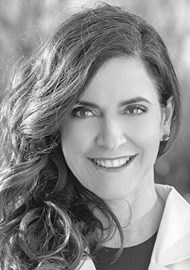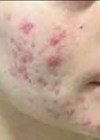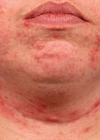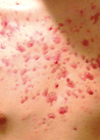Acne vulgaris is a common, globally recognised, chronic condition. According to the Global Burden of Disease (GBD) study, acne vulgaris affects approximately 85% of young adults aged 12-25 years [1]. Acne vulgaris is a disease affecting the pilosebaceous unit (PSU) of the skin and is typically described as either non-inflammatory (open and closed blackheads) or inflammatory (papules and pustules), the more commonly presented of the two [2].
It is well known that acne vulgaris may have a psychological impact on any patient, regardless of the severity or the degree of the disease [3-5]. My patient for this case report arrived with a high level of anxiety that made her continuously manipulate and touch her lesions, leading them to become worse and worse, demonstrated in the evolution of the lesions (something which is quite common and practitioners should look to identify). Current consensus recommends a combination of topical retinoid and antimicrobial therapy as first-line therapy for almost all patients with acne [6]. The superior efficacy of this combination, compared with either monotherapy, results in complementary mechanisms of action targeting different pathogenic factors, but it is not always enough. I add laser and intense pulsed light (IPL) sessions to most of my treatments, this shortens the overall treatment course and improves outcomes to get the desired results.
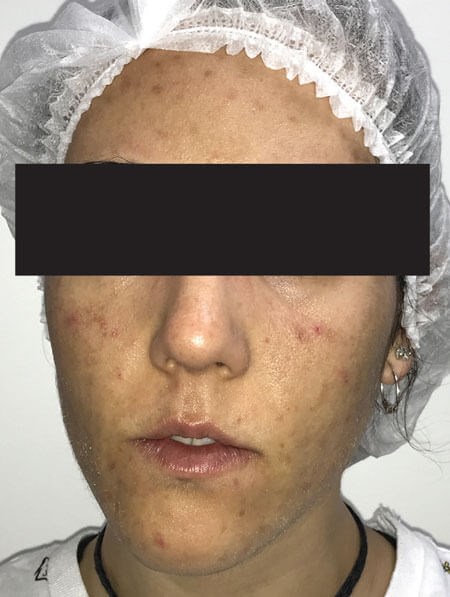
Figure 1: The patient before treatment.
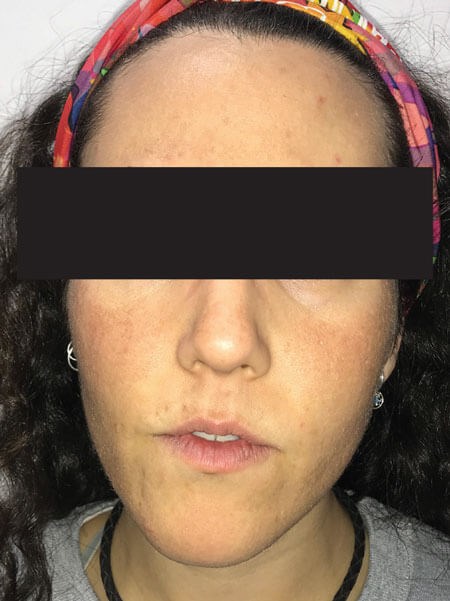
Figure 2: The patient following combination treatment of topical retinoids, antibiotics and laser / IPL.
Case report
A 24-year-old woman came to the office looking to improve her skin texture and treat her acne. During the exploration stage a huge number of active acne lesions, pigmented and inflammatory macules and papules were identified, likely due to residual acne lesions. The patient also presented some erosions and atrophic roller scars. The patient remarked that she continuously handled and touched those lesions. This is a common attitude but not the best for the prognosis of the lesions. The proposed treatment was a combination of topical retinoids, antibiotics and laser sessions as follows:
- Topical retinoids (the patient was reluctant to have systemic treatment) plus clindamycin and alternating with a depigmentation cream containing kojic, phytic and arbutin. I also suggested oil-free cosmetic products.
- Four treatments with non-ablative FRAX 1550 laser and IPL (Nordlys™) once a month.
All treatments were performed after the application of topical anaesthesia (a combination of lidocaine 7%, prilocaine 7% and tetracaine 6%).
First treatment: VL filter (555-950), Double pulse 2.5ms, Fluence (F) 4J, and 10ms delay; followed immediately with FRAX 1550, Spot 10mm, F=47J, Pulse duration 4.5ms, five passes. Finally, I prescribed a recovery cream and sun protection 50SPF until the skin is normalised. Once the skin is recovered the patient can resume their acne treatment again.
Second treatment: VL filter (555-950). Single pulse 9ms, F=14.5J; followed immediately with FRAX 1550, Spot 10mm, F=55J, Pulse duration 5.5ms, five passes.
Third treatment: PR filter (530-750). Double pulse 2.5ms, F=4J; followed immediately with FRAX 1550, Spot 10mm, F=55J, Pulse duration 5.5ms, five passes.
Fourth treatment: Only FRAX 1550, Spot 10mm, F=60J, Pulse duration 6ms, five passes.
The patient showed a remarkable improvement of the vascular and erythematous component, a diminished presence of acne lesions, and improvement in the quality of skin texture and irregularities. The patient was completely satisfied with the outcome.
References
1. Seattle WI. GBD Compare. Seattle, USA; University of Washington; 2013.
2. Bhate K, Williams HC. Epidemiology of acne vulgaris. Br J Dermatol 2013;168(3):474-85.
3. Kellett SC, Gawkrodger DJ. The psychological and emotional impact of acne and the effect of treatment with isotretinoin. Br J Dermatol 1999;140(2):273-82.
4. Kelhälä HL, Fyhrquist N, Palatsi R, et al. Isotretinoin treatment reduces acne lesions but not directly lesional acne inflammation. Exp Dermatol 2016;25(6):477-8.
5. Saluja SS, Walker ML, Summers EM, et al. Safety of non-ablative fractional laser for acne scars within 1 month after treatment with oral isotretinoin: A randomized split-face controlled trial. Lasers Surg Med 2017;49(10):886-90.
6. Thiboutot D, Gollnick H, Bettoli V, et al. New insights into the management of acne: an update from the Global Alliance to Improve Outcomes in Acne group. J Am Acad Dermatol 2009;60(5 Suppl):S1-50.
Declaration of competing interests: Dra Paloma Cornejo has been reimbursed by Candela Medical for speaking at conferences and educational training.
COMMENTS ARE WELCOME


